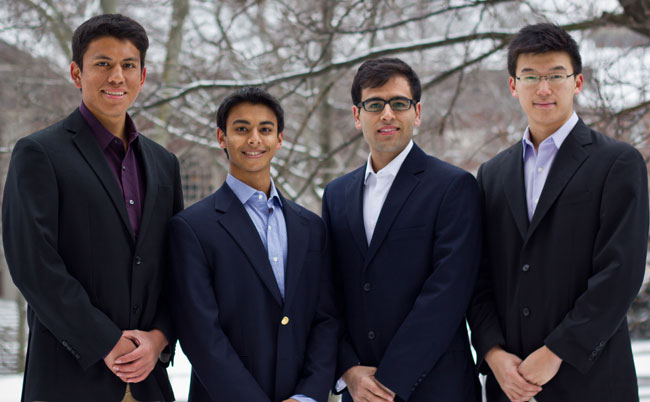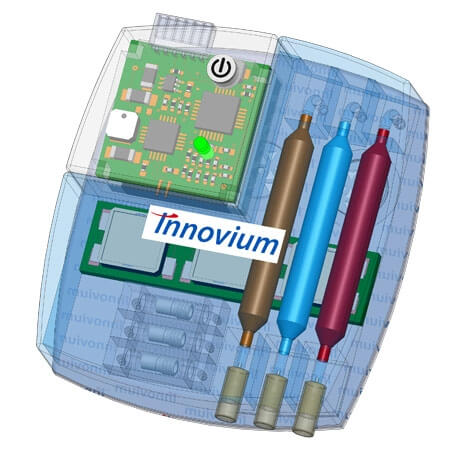News
The ChemoPatch, developed by undergraduates at Harvard, delivers up to three different chemotherapy drugs through an array of microneedles. (Image courtesy of Nikhil Mehandru, Aaron Perez, Alydaar Rangwala, and Brandon Sim.)

Left to right: Aaron Perez '15, Alydaar Rangwala '15, Nikhil Mehandru ’15, and Brandon Sim '15, creators of the ChemoPatch. (File photo.)
Cambridge, Mass. - November 12, 2013 - Four Harvard College undergraduates who invented a chemotherapy patch have won second place in the national Collegiate Inventors Competition. The competition, operated by Invent Now and the National Inventors Hall of Fame, serves as a national platform for showcasing emerging ideas and technologies that will benefit society in the future.
Nikhil Mehandru ’15, Alydaar Rangwala ’15, Aaron Perez ’15, and Brandon Sim ’15, creators of the ChemoPatch, were one of six undergraduate teams selected as finalists to present their inventions to a panel of expert judges at the United States Patent and Trademark Office near Washington, D.C., on November 11. The winners were announced on November 12.
The Harvard team's winning invention is a low-cost, disposable patch that electronically delivers to cancer patients a precise formulation of up to three chemotherapy drugs at specific intervals. By reducing the number of required hospital visits, the ChemoPatch is designed to expand access to early-stage cancer treatment.
"It has the potential to really improve cancer treatment and benefit cancer patients," says the students' adviser, Sujata Bhatia, assistant director for undergraduate studies in biomedical engineering at the Harvard School of Engineering and Applied Sciences (SEAS). "The ChemoPatch will make treatment more cost-effective, less error-prone, and more convenient for cancer patients. This will ultimately enable multidrug, targeted cancer treatment regimens and improve patient compliance."
The idea originated with Mehandru, who is studying engineering sciences and biomedical engineering through SEAS' accelerated AB/SM program. He approached Bhatia as a freshman, wanting to launch an independent project that would improve global health.
"I meet many freshmen who express an interest in pursuing an independent project, and we support all of those students, but many become busy with adjusting to college," Bhatia explains. "Nikhil is exceptional and extraordinary in that he actually followed through and completed significant work on a project during his freshman year."
Over two years, the project evolved as Mehandru was joined by classmates from other fields. Rangwala, who studies applied mathematics, helped the team develop a business plan. With the addition of Perez, who studies electrical engineering, and Sim, in physics, integrating programmable circuitry into the device became much easier.
“We all had conducted research to some extent in high school and each came into the College interested in working on a research project that could potentially be commercialized in the years to come,” says Mehandru. “We met each other through extracurricular activities and classes, whereupon we all decided that we would like to work on an interdisciplinary project, drawing upon each of our individual strengths.”
"This team of students truly represents the breadth of skills offered by the SEAS degree programs, and the spontaneous formation of the team speaks to the incredible intellectual and social community at SEAS," Bhatia says.
The School has supported ChemoPatch through its Nectar funding program, which provides “financial juice” to students’ co-curricular activities. The undergraduate teaching labs at SEAS, led by director Anas Chalah, offered materials, advice, and laboratory space; the Harvard College Innovation Challenge helped the team develop their commercialization plan; and later the Wyss Institute for Biologically Inspired Engineering at Harvard stepped in to offer additional equipment.
The students also found many willing advisers at SEAS, including Prof. Conor J. Walsh, Prof. Robert J. Wood, and the staff of the Harvard Microrobotics Laboratory, whose technical expertise in electromechanical device design and experience with clinical testing helped the team refine their prototypes. Paul Bottino, executive director of the Technology and Entrepreneurship Center at Harvard (TECH) and a lecturer on innovation and entrepreneurship, has advised the students weekly for two semesters through a course called "ES 95r: Start-up R&D." And Bhatia has continued to meet regularly with the team for two years.
"She has really supported us every step of the way, from supporting us when entering competitions, to doing lab work and finding other professors and mentors to ask for advice on specific parts of the device or for additional lab or equipment use," says Mehandru. "We consider ourselves very lucky to be at Harvard, where resources like the SEAS undergraduate teaching labs and world-class professors are available to us."
The prototype ChemoPatch now integrates a reservoir that can hold up to three separate drugs, a micropump to deliver the drugs through an array of microneedles, and an electronic circuit that controls the rate of delivery. The entire device measures just a couple of inches.
"Working on this project was an opportunity to make something from scratch that had the potential to touch people's lives," says Perez. "Learning to take an idea, actually make it, and form a business around it has allowed me to grow both as an engineer and as an entrepreneur."
During the competition, the students had the opportunity to meet with John P. Holdren, a senior adviser to President Barack Obama on science and technology, as well as Todd Park, chief technology officer of the United States.
Past winners of the Collegiate Inventors Competition
2010 was a banner year for SEAS, with students sweeping all of the top awards in the graduate category. Alice Chen, Ph.D. '11, took first place with her tissue-engineered mouse; Erez Lieberman Aiden, Ph.D. '10, shared second place for his work on three-dimensional genomic sequencing; and Bozhi Tian (Ph.D. '10) and Tzahi Cohen-Karni (Ph.D. '11) came in third with their nanoscale intracellular probes.
Other Harvard winners have included:
- Timothy Lu, M.D. '10, who won in 2008 for his antibacterial genetic engineering;
- Undergraduate Colette Shen '04 (engineering sciences), who won in 2003 for stimulating stem cells to produce insulin; and
- Yu Huang, A.M. '02, Ph.D. '03, and Xiangfeng Duan, A.M. '99, Ph.D. '02, who won in 2002 and 2001, respectively, for their work on nanoscale electronics.
Topics: Health / Medicine, Bioengineering, Awards
Cutting-edge science delivered direct to your inbox.
Join the Harvard SEAS mailing list.



